There is a huge number of varieties of pears, but not all of them will take root throughout Russia. One of these universal trees will be Northerner.
It is able to withstand harsh climatic conditions., thereby attracting gardeners living in the northern regions of the country.
Table of contents
Description of the pear variety Northenian Krasnoshchekaya
Variety bred in 1959 PnYakovlev on the basis of the Institute of Genetics and Breeding named after I.V. Michurin.
Medium size treeThe crown of medium thickness resembles a wide pyramid. The branches depart from the trunk at an angle of almost 90 degrees, the bark of the trunk and skeletal branches of gray.
Medium thickness shootslight green, slightly pubescent. The leaves are egg-shaped, the base is rounded, and the tips are pointed, the plate is concave, and the edges are distinguished by the presence of a frequent thread. The scape of a tree is short, the stipule is like a saber.
Flowers gather in inflorescences, most often 4-6 pieces., the color of the petals is white, the stigmas are located below the anthers.
The ripening period falls on the tenth of Augustand lasts until mid-September.
Northerner has good frost resistancetherefore, it is zoned for the Western, Siberian and Ural regions.
Characteristics of the fruit
According to the description of a pear of sora Severyanka Red-cheeked conical shape and in appearance resemble a light bulb. At the beginning of the ripening period, the fruit is greenish with a pink blush, gradually it becomes yellow. The skin is strong, but not coarse.
On average, one pear weighs 80-100 grams, which is small enough for such a fruit crop. The flesh is sweet, juicy, not tart, gently cream color, pronounced aroma in this variety is absent.
Seeds are located in the chambers, which are distinguished by an average size and a small amount of occupied space.
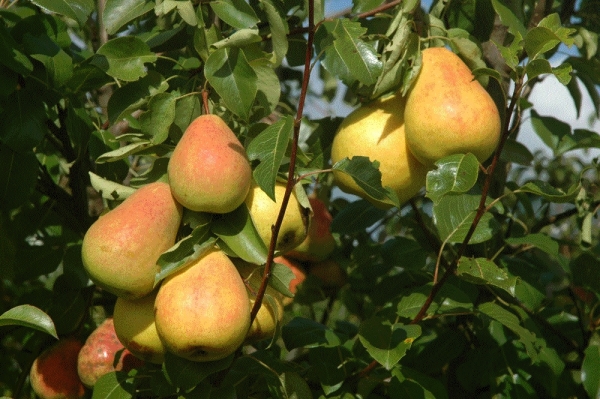
Breeding history and region of breeding
Initially in 1959 at the Institute named after Michurin variety Svetlyanka was bred. It was distinguished by good frost resistance and with dignity endured the harsh Siberian winters. Svetiya went on sale immediately after testing.
But the experiments of breeders did not end there, and a little later at the station in Chelyabinsk, P.N. Yakovlev received a variety of northerners by crossing pears, the favorite of Klapa and Koprechka number 12.
He is still popular among Ural gardeners, but extremely rare large-scale industrial landing Northerners.
Advantages and disadvantages
Pros:
- its high frost resistance characterizes it well for growing in the northern regions with a harsh climate;
- Northerner's tree is small and compact, which makes it possible to grow pears even on small plots of land;
- early ripening, fresh fruit can be pampered in August;
- with proper care, one tree brings up to 100 kilograms of crop;
- Severyanka resistant to scab;
- Used for various purposes.
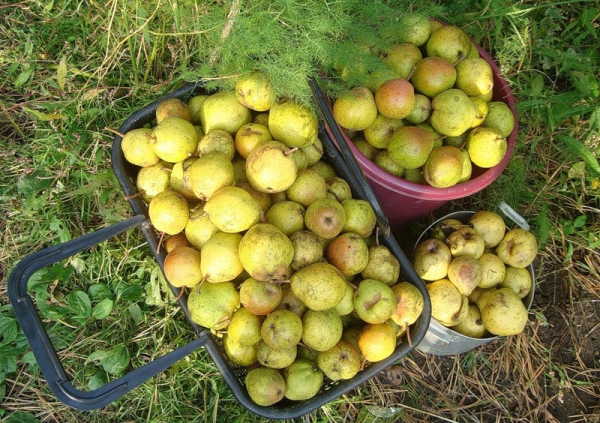
Minuses:
- a large number of fruits fall off before the deadline, so you can not skip the harvest period;
- pears themselves are rather small in size and do not differ in outstanding taste;
- this variety must be watered in a timely and abundant manner, because it does not tolerate an insufficient amount of moisture;
- small shelf life and poor transportability make Severyanka not attractive for commercial purposes.
Features of planting seedlings and care
To plant a tree in the garden, First you need to decide on the place where it will grow. In this case, the characteristics of the selected grade are taken into account:
- sandy or loamy soil with a lot of humus is best suited for Northerners;
- groundwater should be no closer than 2 meters from the ground, otherwise the root system of the pear can erode and the tree will die;
- You also need to provide reliable protection from the wind and good solar lighting.
Time is chosen depending on the climate and region of cultivation.A tree planted in the fall is less likely to survive a harsh winter.
For pear digging ditch, whose dimensions will be 60 centimeters in depth and 1 meter in width. At the bottom of the pit is laid fertile mixture consisting of:
- 2 buckets of compost or humus;
- 200 grams of potash fertilizer;
- 800 grams of superphosphate.
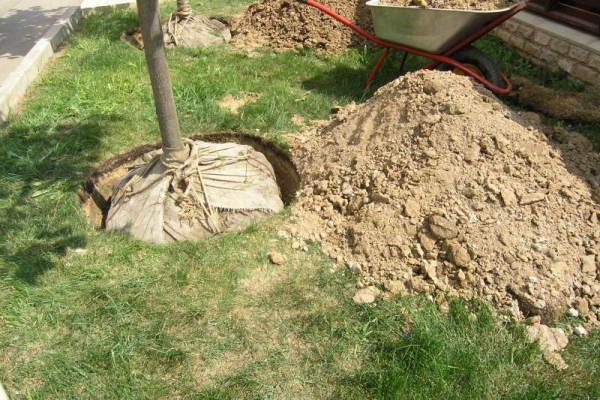
The prepared soil must be infused, therefore dig a hole should be a week before planting trees:
- To begin with, the roots are dipped in a clay mash.
- Then damaged and broken branches are removed, so that the plant spends more strength on adapting to the new terrain, and not on treatment.
- Then the seedling is placed in a hole and gently sprinkled with earth.
- A peg is placed neatly near the tree, which will act as a support, and a newly planted plant is tied to it.
- The final stage will be abundant watering.
Growing conditions
Variety Severyanka can please gardener fruits already in the 4th year of life, but for this you need to properly care for the tree and give it the necessary nutrients.
Immediately after planting, the seedling is pruned. If there are no skeletal branches on it, then the stem is cut at a height of 80-90 centimeters from the ground.
Then the tree will only require sanitary pruning., thanks to which the gardener to get rid of sick, dried or extra branches. Young shoots are regularly removed from the tree.
To get the roots as much oxygen as possible loosen the ground in the wheel circle. Also need timely get rid of weeds.
Considering that Northerner loves moisture it must be watered regularly, preventing the soil from drying out.
In the summer, once a season they make mineral dressing, in the fall, the tree is fertilized with humus or manure.
Although Severyanka refers to frost-resistant varieties, it must be properly prepared for winter. To do this, before starting the frosts, the tree is plentifully watered and mulched, thereby protecting the root system.
Harvesting and Storage
Harvest period falls in mid-August and may last until early September. Closer to the autumn period, the flesh of the pear becomes brown. Ripe fruits begin to fall off and within 2-3 days the tree loses the bulk of the crop.
If the pears are fully ripe, then they will be stored no more than 10 days. At the same time they need to provide a cool temperature and wooden or wicker containers.
Experienced gardeners recommend harvesting a week before full maturity, in which case the least amount of harvest will have time to fall and it will be stored much longer (2 months).
The best place is considered cold cellar., but instead use the lower compartment of the refrigerator.

Special features
The main distinguishing feature of Northerners is a high winter hardiness. There were cases when only young trees died during short-term frosts down to -50 degrees, and with a stable temperature change down to -42 degrees, only the above-ground part of the tree was frozen out, while the root system was maintained.
Also such the grade is quickly restored after frosts.
This is explained by the fact that breeders have brought a lot of other frost-resistant varieties that are more attractive and have more advantages.
Severyanka is used in scientific work, and it has already become the parent form for varieties such as Yeseninskaya and Tyutchevskaya.
Another feature of the variety will be the need for pollination, because if you carry out the procedure yourself, only 30 percent of the fruits will be tied.
Yakovlev Memory will be the best pollinator for Northerners, such trees are advised to be placed next to each other.
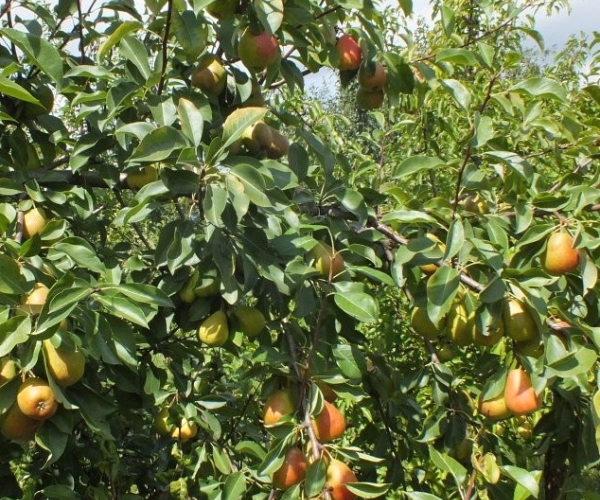
Diseases and pests
Severyanka extremely rarely exposed to diseases and pests. It has good resistance to scab. Most often on the trees of this variety are the following diseases:
- Microplasma disease or witch broom is the most dangerous disease for the fruit tree. It spreads through insect pests or with seedlings. The center of the disease cannot be cured and in this case the tree will have to be completely uprooted and burned.
- Fruit rot - infects pears, the first stage is the appearance of brown spots, which eventually grow and destroy the crop, copper chloride or Brodsky liquid is used as the control methods.
- Bacterial burn - appears after freezing leaves. When a disease is detected every 5 days, the tree is sprayed with antibiotics. To avoid the spread of bacteria, all tools are treated in boric acid.
As a fight with her at the moment of accumulation of a large number of caterpillars on the tree, it is treated with drugs "Karbofos", "Spark" or other insecticides.
The main method of dealing with any disease or pest will be the removal of all traces of their habitat, i.e. infected parts of the tree, fallen fruits or leaves that need to be burned immediately.
As a prevention of the appearance of diseases Trees need to be well maintained; watering, feeding and sanitary pruning are done on time. In autumn and spring it is recommended to spray the plant with Brodsky liquid.
When working with any chemicals you need to use personal protective equipment.
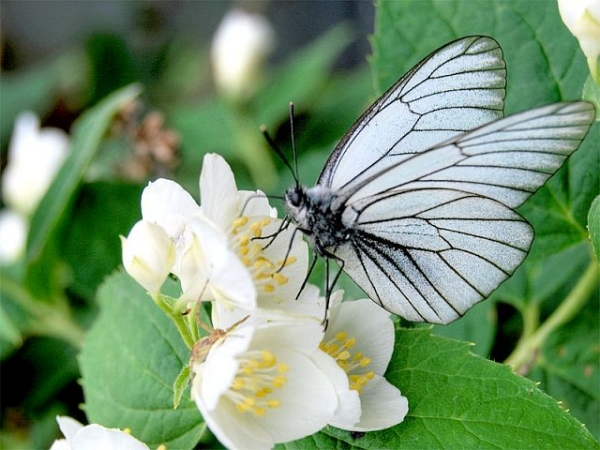
Gardeners reviews
Galina: “Northerner is the oldest inhabitant of my garden.Harvest gives a huge amount, in the early years overeat, now even remains. From this grade I twist juices, recently began to dry pears. The taste of the variety is very pleasant, sweet and sour with a slight tartness, pears are relatively small with a red side. It is not difficult to care for a tree, especially now that it is already mature and adapted to our climate. ”
Olga: “It was also my father who grew up Northerner, we have a dacha in the Urals, so it’s very difficult to find a good pear variety. Now there are a lot of fruit trees on the site, which are several times better than Northerner, but I cannot decide to uproot it. It fruits steadily from year to year, tolerates low temperatures, besides it has a pleasant taste. Compote from this variety is the taste of my childhood and I myself continue to make it for my children. ”
Vladimir: “There are a lot of different trees on my site, and Severyanka played a significant role here. It is an excellent pollinator for many varieties, moreover, using the stock, it can be used to obtain other fruits of higher quality in taste and shape. The winters are harsh and the adult tree perfectly tolerates them. ”
Northerner has long lost its relevance and is currently not used on an industrial scale.
But amateur gardeners don't want to say goodbye to this tree., finding in it more and more advantages, at times, not noticing the numerous shortcomings of the variety.
